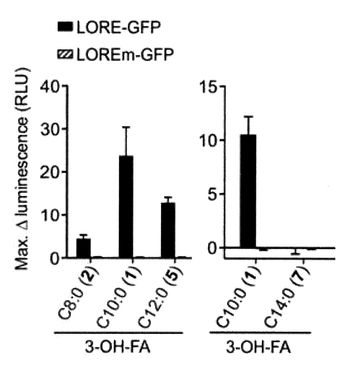Triggering of plant immunity through bacterial hydroxy fatty acid metabolites
Challenge
Bacterial infections of plants are difficult to control and their prevention and choice of resistant plant varieties is crucial. Plants evolved diverse intracellular and extracellular immune receptors to detect potentially harmful invaders directly (recognition of non-self) or indirectly through cellular perturbations (recognition of modified-self). Sensing of characteristic microbe-/pathogen-associated molecular patterns (MAMPs/PAMPs) by plant cell-surface pattern recognition receptors activates cellular responses resulting in broad-spectrum pattern-triggered immunity (PTI). Bacterial lipopolysaccharide (LPS) and its component lipid A (LA) activate characteristic PTI responses via the plant-specific bulb-type lectin receptor kinase LORE/SD1-29 (LORE) in Brassicaceae. Understanding the plant defense mechanisms will have a tremendous application in designing crop plants with better protection against invaders. Furthermore, this knowledge can be used to biotechnologically exploit specific genetic designs for sustainable agriculture.
Technology
The researchers deciphered the structural features of LPS/LA sensing by LORE. Structurally, all tested LPS/LA that elicited LORE-dependent responses comprise a short acyl chain, most notably 3-OH-decanoyl, suggesting that this decanoyl chain is a key structural feature for LORE-dependent immune sensing. Synthetic 3-hydroxy fatty acids (3-OH-FAs) were tested for their ability to induce PTI responses. Medium-chain (mc) 3-OH-FA metabolites (8-12 carbon atoms) were able to activate cytosolic calcium signaling, LORE-dependent reactive oxygen species production and transcript accumulation of PTI response genes. Wild-type Arabidopsis plants pre-treated with 3-OH-C10:0 were more resistant to infection with virulent Pseudomonas syringae, whereas systemic resistance was not activated in Arabidopsis lore-1 mutants. In addition, Nicotiana benthamiana, previous insensitive to 3-OH-FAs, gains responsiveness upon transient expression of a functional LORE gene demonstrating that LORE is pivotal for sensing of 3-OH-FAs. In conclusion, mc-3-OH-FAs are sufficient to trigger LORE-dependent immunity with free 3-OH-C10:0 exhibiting the strongest elicitor activity. Elicitor-active mc-3-OH-FAs originate from LPS/LA but apparently also other metabolic source pathways in bacteria and possibly also other microorganisms.
Commercial Opportunity
It could be demonstrated that ubiquitous low-complexity and free mc-3-OH-FA metabolites trigger typical PTI responses depending on a direct interaction with the cell-surface receptor kinase LORE. Engineering plant species with a functional LORE gene (i) and sensing of plant species with mc-3-OH-FAs (ii) may provide powerful strategies to increase broad-spectrum resistance in plants. In particular, by contrast to most other known MAMPs, mc-3-OH-FAs are applicable for field applications as they can be (biotechnologically) produced with reasonable amounts and costs.
The technology is open for licensing, further co-development is highly welcomed
Development Status
The researchers have engineered LORE in Arabidopsis for enhanced and prolonged signaling output. Transgenic Arabidopsis lines overexpressing this LORE variant are hyper-resistant to bacterial leaf surface inoculation. In addition, LORE and the improved variant has been transferred into 3-OH-FA-insensitive tomato. First results indicate that transgenic tomato lines stably expressing LORE or its variant gained sensitivity to mc-3-OH-FAs (and also bacterial attack) and trigger typical PTI responses
Patent Situation
A PCT patent application has been filed (priority May 2018)
Further Reading
Kutschera et al. (2019), Science 364: 178-181




